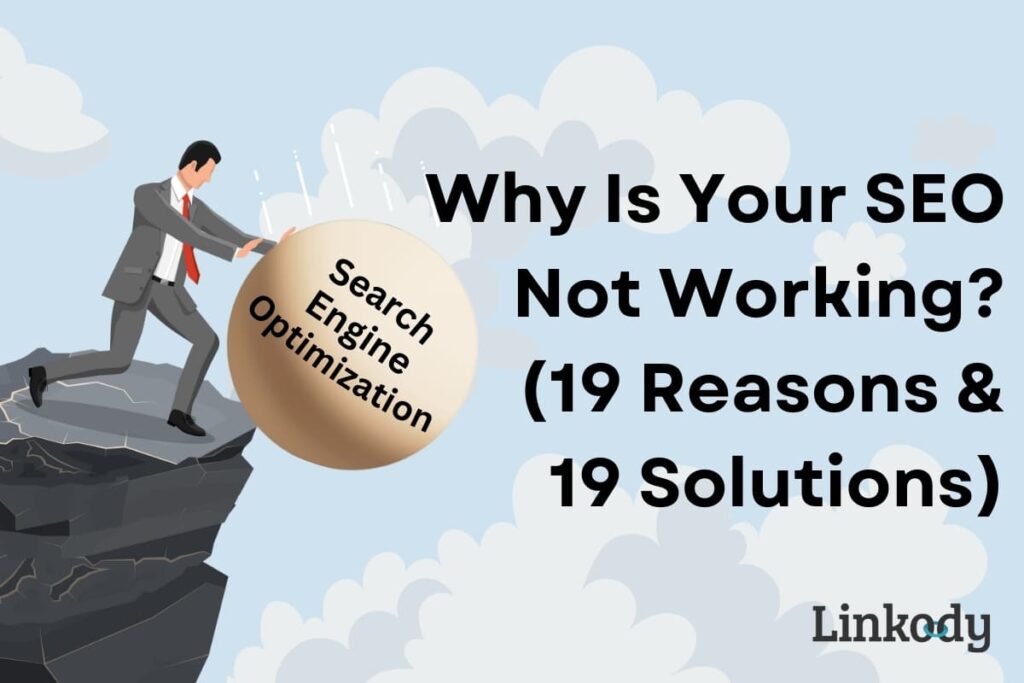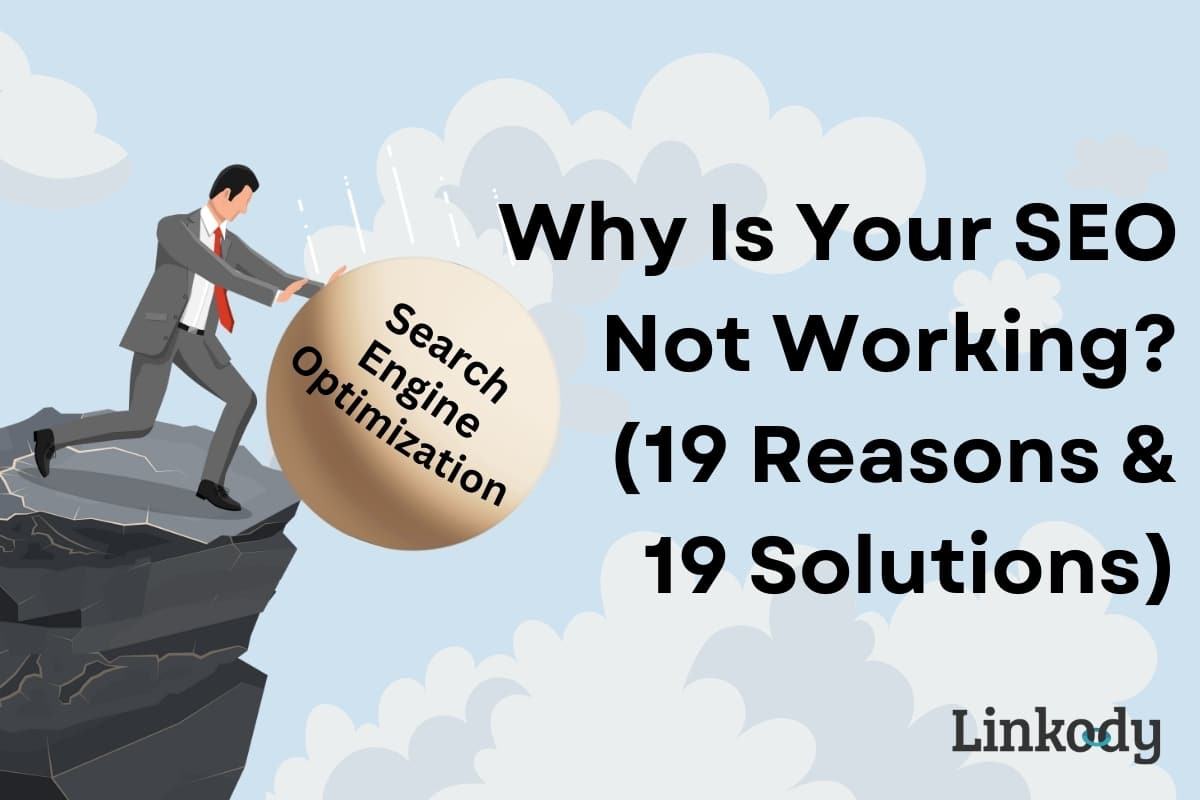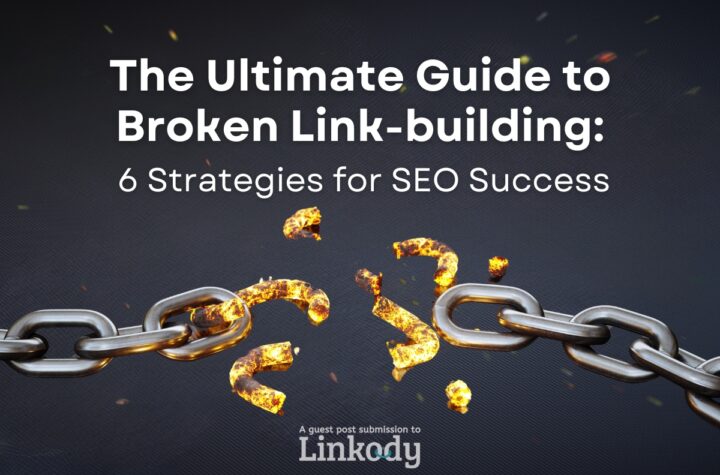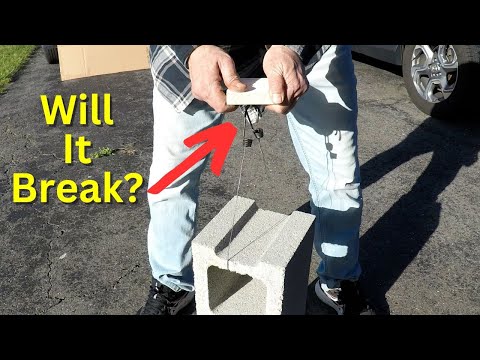

Marketers and businesses alike have highlighted SEO as an effective tool to drive traffic and conversions to a website.
In hopes of basking in this lucrative opportunity, you may have hired an SEO company or decided to wing SEO yourself.
But after months of dedication, you hardly see any improvement in your monthly traffic or SERP ranking.
So, you ask yourself, “Why is my SEO not working?”
Worse, you might have gone to the ultimate conclusion that “SEO doesn’t work for me” or “SEO offers zero value to my company.”
It’s frustrating, I get it. More often than not, SEO not working is a product of multiple factors.
Some issues may stem from internal factors that you have complete control over. Others may result from external challenges that you have to withstand to thrive.
However, there are cases when internal complications, like having unrealistic expectations or dealing with budget constraints, become the bottleneck to your site’s SEO.
In this article, we’ll go over the 19 reasons why your SEO may not be working and provide solutions to turn your situation around.
Factors Behind Your SEO Not Working

It can be aggravating when you start your SEO journey filled with hope but, in the end, fail to attain what was promised. This is especially infuriating when you can’t figure out why.
Through years of engaging in SEO, we’ve found that the disparity between your SEO expectations and reality may come from 6 areas:
- On-page optimization issues
- Off-page optimization issues
- Technical optimization issues
- Mishaps in the market or industry
- Google-influenced problems
- Issues within the company
The following reasons behind SEO not working for your company may come from one of the above aspects. By dealing with the problems plaguing your SEO, you increase the likelihood of getting your SEO back on track.
On-Page SEO Issues
On-page optimization issues refer to problems on your website that hinder its search engine ranking. These problems prevent search engine crawlers from fully understanding your content and how well it aligns with a user’s search intent.
Below are examples of on-page optimization issues you may encounter:
Reason #1: Low-quality or thin content
Content is the footstool of search engine optimization. Without any content on your website, ranking on search engines will be difficult.
However, we have to remember that not all pieces of content are the same. Some are valuable in the eyes of Google and its users, others are not.

Low-quality content refers to content that offers little to no value to visitors searching for information, therefore failing to deliver what users expect from the page.
Thin content, on the other hand, refers to content with a very low word count, which lacks the depth needed to explore a topic. As users, you don’t just want reader-friendly web content. Having access to substantial and comprehensive answers to your simplest questions is more important.
Unfortunately (but quite expected), Google penalizes websites that produce low-quality content. This hurts your ranking in SERPs.
Solution for low-quality or thin content
Invest time and effort in doing deep research before the content-creation process, like writing a blog.
Avoid replicating other people’s material and always aim to produce something original. Google (and even the law) values plagiarism-free content.
Actively demonstrate E-E-A-T in your SEO. This abbreviation stands for Expertise, Experience, Authoritativeness and Trustworthiness. With these four emanating from your content, you are set to capture people and Google’s attention.
Finally, always write with the end-users in mind. When users are happy, Google is happy.
Reason #2: Poor keyword research and targeting
Keyword research is a way to get into the minds of users within your industry by looking at the most popular search queries. However, one reason behind SEO not working is the misuse of keyword research.
Many people treat keywords as supplementary terminology that needs to be integrated into the content. Using keywords is more than just overusing and stuffing them throughout your content!
If you find yourself asking which between high or low search volume keywords to target, divert your focus toward short vs. long-tail keywords instead.
Keywords are guides to knowing which segment of the marketing funnel you must target.
For instance, short-tail keywords typically target top-of-funnel or cold leads. These are people who may not know about your company and are only looking for relevant information surrounding your niche.
Conversely, long-tail keywords are used for top-of-funnel or warm leads. This segment includes those who know your company, are impressionable to selling attempts, and just need a little persuasion to fully commit to buying.
Keyword research or keyword mapping is used to target audiences depending on their position in the marketing funnel. Without proper targeting, you may miss out on potential sales or drive leads away.
Solution for poor keyword research or targeting
Find the right keywords that speak to the right audience. When targeting short-tail keywords for content, avoid overselling your product to prevent leads from steering clear of your website.
Conversely, when using long-tail keywords, integrate a good bit of direct-response copywriting to influence warm leads into buying your solutions.
Reason #3: Misaligned content and search intent
Piggybacking off Reason #2, keywords are also tools to determine the search intent of users. Without accounting for the search intent in a given “keyword,” no one will be interested in your content. Basically, what happens is you’re answering a question that no one asked.
Search intent refers to the user’s intention behind the search. One Google search can reveal the search intent behind a query.
For example, with the query “buy shoes,” results are mostly online merchants selling all kinds of shoes. This is because buying shoes has a transactional search intent behind it or the search intent of a warm lead who is ready to make a purchase.

Targeting ‘buy shoes’ as a keyword for informational content will bring little to no results. Think about it. Nobody searches ‘buy shoes’ to read a blog.
Solution for misaligned content and search intent
Before starting the content creation process, take time to search your keywords on Google first to get a feel of the search intent behind the query. Always create content that aligns with the user’s search intent, otherwise, your efforts are in vain.
Reason #4: Lack of on-page optimization
Search engine optimization is never a one-and-done ordeal. Viewing SEO as such might be the reason why SEO is not working out.
Even the most brilliant content can get lost in the search engine shuffle if you stop optimizing them. Conversely, users will reap the full benefits of SEO with consistent optimization for search engine results.
On-page optimization is the process of optimizing the visible elements of your website. This includes your content, meta descriptions, title tags, header structures, images, keywords, etc.
With proper on-page optimization, search engines will have a better grasp of your content’s topic, relevance, and value.
Solution lack of on-page optimization
Always optimize your title tags and meta descriptions by incorporating relevant keywords. This is especially important when your content ranks high on SERPs but gets low CTRs.
Make sure that your on-page content also has a respectable amount of white space to prevent people from bouncing off your page. For non-evergreen pages, remember to update the provided information to keep the content fresh.
Moreover, be on the lookout for keyword data from Google Search Console to help further refine your material.
Reason 5: Over-optimization
While on-page optimization is important, one might fall into the trap of over-optimizing content in hopes of ranking it better on SERPs. This becomes a problem as well.
Optimizing your content is different from being all ballistic on it and going over the top to do it for ranking’s sake. Over-optimization may also mean engaging in unnatural tactics to manipulate search engines in your favor.
One prime example is keyword stuffing or the unnatural integration of keywords to the point that the article’s prose becomes problematic.
Below is an example of keyword stuffing with the keyword “problems with mobile phones”:
“Are you frustrated with problems with mobile phones? Do problems with mobile phones cause you to miss important calls or experience dropped connections? Have you ever been irritated by problems with mobile phones such as a cracked screen or a dying battery? If you experience problems with mobile phones regularly, you’re not alone! This article will delve into the many problems with mobile phones and how to troubleshoot them.“
Solution for over-optimization
Optimize but never over-optimize. As they say, “Too much of a good thing is a bad thing.”
Off-page SEO Problems
Off-page optimization issues involve factors outside your website that equally affect your search engine ranking. Unlike on-page SEO, which focuses on your website’s content and structure, off-page SEO deals with how the wider web perceives your site.
Reason #6: Ineffective backlinking efforts
Backlinks are one of the three identified factors that influence Google search ranking. With a good backlink profile, sites are more likely to land on Google’s page 1 results since backlinks transfer valuable link equity from the linking pages. However, a poor backlink profile may very well be the reason behind SEO not working.
A bunch of low-quality no-follow backlinks might not be a problem. However, getting do-follow backlinks from low-quality, spammy sites that are unrelated to your niche waves a massive red flag at Google’s face.
Google may tag your page or domain as spammy, thereby limiting your visibility in search engine results pages.

Solution to ineffective backlinking
Backlinking is arguably one of the most important factors for SEO success. However, backlinks can also hurt your SEO when left unchecked.
As much as possible, do not engage in link sales. While Google recognizes the normalcy of buying links in the digital economy, they are strict about qualifying the links with the proper tag.
Only rel=’sponsored’ and rel=’nofollow’ tags are allowed for purchased backlinks. Without proper qualifying, Google might penalize you for engaging with this transaction.
Also, avoid excessive link exchanges. Having a natural backlink profile is more ideal than unscrupulously improving your search engine ranking using reciprocal links.
Google appreciates backlinking efforts better when they are created via high-quality and backlink-worthy content.
Linkody is a robust tool that helps you assess and monitor the quality of your backlinks. If you start noticing fluctuations in your backlink profile or a surge in spammy backlinks, lInkody is equipped with a disavow tool to snip your site’s connections from the linking pages.
Reason #7: Neglecting Local SEO (if applicable)
If you’re a local business owner, ranking for global keywords may be a huge waste of time and resources. For one, global popularity will not translate to an increase in conversion rate. Targeting a global audience may even be the reason behind SEO not working.
Local SEO is the process of optimizing websites or businesses for local search or listings that have business value for a company. Engaging in local SEO helps you capture customers within your locality.
For example, a plumbing company based in Wisconsin won’t get a single service call even if their business is widely popular in the Philippines.
During local searches, companies ranking for local keywords bag the first page results. Plus, you also have better chances of appearing in Google’s map pack, as shown below:

Solution for more effective local SEO
Implement proper keyword research and find keywords that target audiences within your geographic area. This allows your business to appear on search results for your specific locality.
Take advantage of customer reviews to boost your local SEO performance.
Reason #8: Overlooking competitor analysis
In a competitive marketing landscape, understanding your competitors’ strategies is a gold mine for success.
Here are three ways how competitive landscape analysis can boost your site’s SEO and elevate you above competitors:
- Competitors may be ranking for valuable keywords you have overlooked or haven’t even considered. Targeting the same keywords and creating a better version of those topics puts you ahead in readers’ eyes.
- Competitor analysis allows you to find content gaps between you and your competitors. Content gaps are hidden gems that none of your competitors have explored yet. This makes you the pioneer in the industry once you create content surrounding them.
- Competitors may employ practices that you can integrate into your own SEO strategy. Try to see and analyze how they approach SEO and learn from their successes.
As competition gets tighter, knowing what makes competitors succeed is crucial to supplement your established efforts.
Solution for overlooking competitor analysis
Get a feel of what kinds of content your successful competitors are creating.
Try to replicate their content structure and produce content that is more in-depth than what they make.
Also, being familiar with their backlink profile can play a huge part in understanding what makes their website succeed.
Technical SEO Complications
Technical SEO optimization issues refer to problems with the underlying structure and code of your website.
Like on-page and off-page optimization problems, technical SEO complications can also your site’s search engine ranking.
These issues prevent web crawlers from efficiently crawling, indexing, and understanding your content.
Below are reasons why technical SEO complications can kill your SEO.
Reason #9: Slow website speed
In this fast-paced world, a quick-loading website is no longer considered a luxury— it is a necessity. As a matter of fact, page experience (which includes site speed) is one of the core web vitals in Google’s ranking systems. That means the loading speed of a website may influence how well your website performs on search engines.

Solution to slow site speed
The best way to prevent a slow website is to optimize large images using compression tools without sacrificing quality. Another solution is implementing caching mechanisms to allow returning visitors to experience a faster loading time. Moreover, a reliable web hosting provider with a robust infrastructure can ensure your website has the resources to load optimally.
Reason #10: Lack of mobile optimization
It’s no secret that smartphones are taking the world by storm. Compared to 10 years ago, the use of smartphones has become even more popular, with smartphone users accounting for 85% of the population.

Naturally, with more people using smartphones, they are also likely to use the handheld devices for mobile searches. Google caught wind of this trend, making mobile-friendliness a golden standard if websites want to succeed in SEO. Websites unoptimized for mobile may likely be the reason behind SEO not working.

More importantly, websites not optimized for smartphones and tablets are missing a massive chunk of potential traffic.
Solution for lack of mobile-friendliness
Embrace mobile-friendliness for SEO success. This can include using a responsive website design and theme, optimizing speed for mobile search, and manually testing website responsiveness or various devices.
If you’re not one to code, you may use SEO-friendly website builders to create mobile-friendly websites.
Reason #11: Sheltering broken links
Even the most compelling content can be overshadowed by underlying technical issues. One of the most persistent technical problems is broken links.
Broken links, as the name suggests, are dead ends for search engine crawlers and users. When users click on broken links, they are met with a page bearing an error 404 message, resulting in a negative user experience.
Search engines may also view these broken links as a sign of poor website maintenance, which may affect your ranking.
Solution to broken links
Schedule regular link audits to identify and fix technical issues. SEO tools help greatly in identifying broken links throughout your website.
LinkStorm is a comprehensive SEO toolkit for automating internal linking across a website. But on top of its internal linking functionality, it also tracks internal linking issues like broken links that can hamper a user’s experience.
Reason #12: Harboring duplicate content
Duplicate content is another technical error that many websites often deal with. As the name suggests, duplicate content refers to content similarity appearing on multiple pages across your website. Content duplication happens when two web pages target the same keywords or the same topic.
Unknowingly harboring duplicate content leads to content cannibalization. This is a situation where search engines get confused about which duplicate pages should be ranked in response to a search query. As a result, duplicate content dilutes the pages’ ranking power and limits the SEO potential of your website.
Here is how it happens. For instance, let’s say you have two pages:
Webpage #1: www.myexampleonly.com/power-rangers/who-is-the-strongest-ranger
Webpage #2: www.myexampleonly.com/super-sentai/who-is-the-strongest-ranger
If webpage #1 garners 20 backlinks and webpage #2 only gets 15, both duplicates only get a fraction of the backlinks. Whereas a single webpage could have gotten 35 backlinks that further boosted its SEO potential.
Duplicate links are also known to waste a search engine spider’s crawl budget (or the amount of time spent crawling a website). In other words, some pages might not be crawled because the crawl budget was spent on the duplicate page.
Solution to duplicate content
If you transferred a page to a new location or revised its slug, you may implement a 301 redirect to lead users to the intended web page and prevent dead ends from happening.
When you observe duplicate content from your web of pages, consolidate them by identifying the canonical version. You may then implement a robots.txt file that disallows web crawlers from crawling and indexing the non-canonized duplicate content.
Market Mishaps
While SEO not working is highly influenced by underlying SEO issues, the industry or market may also play a crucial role in a company’s lackluster SEO success.
Below are two ways market mishaps may limit the SEO potential of a website:
Reason #13: Highly competitive industry
A crowded online marketplace can make ranking for keywords challenging to overcome at times. This is especially true if you are a small business going up against industry giants.
It is likely that established websites already capture the top-ranking spots and command a fleet of followers.
These websites may also likely possess a strong backlink profile, high domain authority, and a wealth of valuable content, putting you at a disadvantage when going up against them.
Moreover, competitive industries tend to have high-volume keywords saturated by already established players. Your best shot at being successful SEO-wise is competing for low-competition keywords, but even this will be a long and difficult battle.
Solution for a highly competitive industry
Winning a saturated industry in terms of SEO is not impossible, but it is extremely challenging. As such, we recommend that you do not rely on SEO efforts alone because this approach takes time to fruition.
Sometimes, paying for ads for immediate attention is better than waiting for years before your site attains a competitive level. Investing in social media management or advertising may also bolster your SEO efforts.
Reason #14: Lack of demand
It’s a rare occurrence when SEO isn’t essential for a business.
However, there are instances when search engine optimization is not the best marketing solution for a given product or service. If that is the case for your business, then it might be the culprit behind SEO not working.
Remember, the power of search engine optimization is directly related to the search volume in your niche. The more search volume, the more powerful SEO becomes as a tool.
If you have a very specific niche or sell a highly technical product with zero public awareness and no monthly active searchers, then you won’t get as much ROI from SEO as other marketing approaches.
Solution for lack of demand
Despite being a niche product or service, it pays to have a website. You may also include a few essential resources to articulate the value of your product or service. But to bust out content consistently for SEO’s sake? Not really.
In the age of social media, creating a buzz through short-form digestible content like Instagram reels, Facebook shorts, YouTube shorts, or TikTok is way easier.
Searchers can then visit your website and read your resources once enough interest is generated through those marketing platforms.
Google Troubles
Let’s face it. Sometimes you are already employing all the good practices you acquired from online SEO gurus but your SEO efforts still fall short of elevating your business. Perhaps the problem is not you— it’s Google.
The ever-changing nature of search engines can be hard to pinpoint, especially with Google’s core algorithm updates. This can sometimes leave even seasoned SEO professionals scrambling to recover when their sites take a hit.
Reason #15: High-impact algorithm updates
Following an algorithm update, SERP rankings can experience fluctuations. Some industries may experience worse fluctuations than others.
During fluctuations, pages previously ranking well might suddenly drop positions, causing confusion and frustration for webmasters.
For instance, last March 6, 2024, Google did a massive crackdown on unhelpful, irrelevant, and thin pieces of content, which are typically products of generative AI. This massive change resulted in websites suffering from ranking fluctuations and remove from Google’s index.

While Google once recognized that using generative AI is not against their policy, relying heavily on GenAI for producing low-quality content is. If you still think generative AI is the future, that might not be the case, as far as SEO is concerned.
Solution to weather high-impact algorithm updates
Always be on the lookout for SEO news and updates from reputable sites and social media pages. This gives you a quicker response time in case your website is hit with an SEO-damaging algorithm update.
Moreover, since updates remain relevant from the day Google implements them. Ensure that your site diligently follows Google’s parameters to remain under their good graces.
Reason #16: Penalties from Google
Concerning Google algorithm updates, websites that fall short of Google’s standards become victims of the search platform’s penalties. Incurring a penalty can severely hinder your SEO efforts.
Some penalties are manageable like ranking downturns. While this decreases your organic traffic and potential customers, recovering from such an impact is fairly manageable.
However, the worst penalty you can get from Google is to be removed from their index. During the March 6th fiasco, even a popular SEO guru and a Google executive were not safe from getting scraped off Google’s radar.
If you keep on violating Google’s strict policies, your site will consistently remain on its naughty list. This limits your site’s SEO potential.
Solution to resist penalties from Google
Ensure that your site is free from violations of Google’s policies and rules.
Company Hurdles
Sometimes, the issue behind SEO not working is neither from the technical aspects of your SEO approaches nor external influences. It also helps to look inward and see if your company itself is bottlenecking the growth of your website.
Below are three instances when company hurdles might be the reason behind SEO struggles:
Reason #17: Insufficient budget to maintain SEO services
Search engine optimization is NEVER free.
Whether you hire an SEO agency to do your bidding or DIY your SEO efforts, you will have to dedicate time and effort.
And, as the saying goes, time is money (add to the fact that you have to shed dollars to actually pump gas into your team).
Unless you wing your SEO and do not count your personal work as paid work, having an insufficient budget will set an invisible ceiling on your SEO growth.
Solution to insufficient budget
One solution to get the SEO engine running despite budget constraints is learning how the SEO system works.
This way, you can be stringent on your budget by doing the heavy lifting yourself. While results are not assured, at least doing SEO yourself won’t put your SEO efforts to a complete halt.
Moreover, continuously publishing high-quality content also helps keep your website active.
Once you get enough runway to fund your SEO, it’s best to re-invest in a reliable team that can take your site’s optimization efforts off your hands.
Reason #18: Unrealistic SEO expectations
SEO has never been the be-all and end-all of all marketing approaches. If we view SEO as the final string that will keep our business from falling apart or the magical genie that will grant us customers, we might want to snap back to reality.
Search engine optimization, just like any other marketing strategy, requires in-depth planning, projection, and benchmarking. Otherwise, we’re anchoring our hope on wishful thinking.
Solution to dealing with unrealistic expectations
Let’s be real. There are no shortcuts to success, especially in SEO where Google is the governor of website performance. Wait it out and see how your efforts pay off.
If unsatisfied, you can always go back to the drawing board to recalibrate your strategies and experiment (of course, within the realm of Google’s prohibitions).
And speaking of waiting…
Reason #19: Giving up too soon
You can’t expect a fruit to taste sweet if you harvest it out of season, right?
We must also view SEO by that same standard. Search engine optimization results take time. Sometimes, it may take several months or even years before your efforts pay off.
If you notice, no actual SEO professional commits to a specific timeline for SEO results to happen. It’s because Google SERPs are very variable.
Sure, we know that content, backlinks, and Google algorithms impact SEO. But accurately timing your content marketing ROI and SEO profitability is still impossible.
Here’s the kicker: While positive results are uncertain, one thing is for sure, impatience and pulling the plug too soon will SURELY result in SEO not working.
Solution for waiting for results
Here’s a quick advice:
The more competitive the industry, the more time you need to brew profitable search results.
Moreover, if you’re dealing with more issues before you get an SEO professional on board, expect to wait even longer.
It is what it is.
In any case, if the SEO strategy works, the benefits will far outweigh the waiting period and resources initially invested.
You can still turn this around
SEO not working can be a pain in the budget and a tough headache to deal with.
If you’re suffering from unprofitable SEO efforts, take a quick look at any of the reasons above.
With enough time and a strategically planned approach, you can turn your non-working SEO around.
It all begins with accepting that SEO is a time-consuming and budget-depleting process. Once you make peace with this fact, investing (or not) in SEO becomes an easier pill to swallow.
You can do this!
Know that Linkody is rooting for you.
The post Why Is Your SEO Not Working? (19 Reasons + 19 Solutions) appeared first on Linkody's Blog.





More Stories
The Ultimate Guide to Broken Link Building: 6 Strategies for SEO Success
SEO Game Changer: How Topic Clusters and Pillar Pages Can Skyrocket Your Rankings?
Every AI SEO Tool Mentioned At Pubcon Vegas